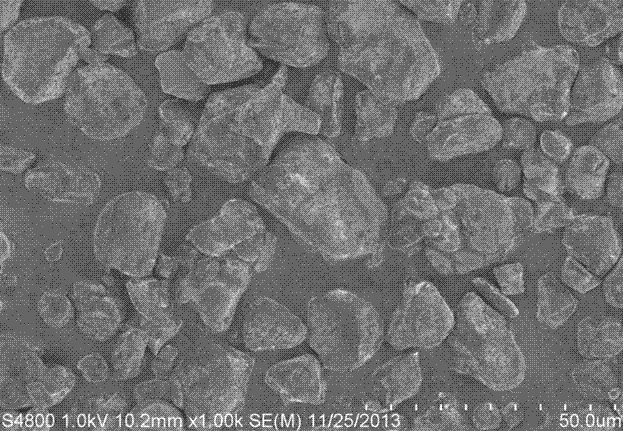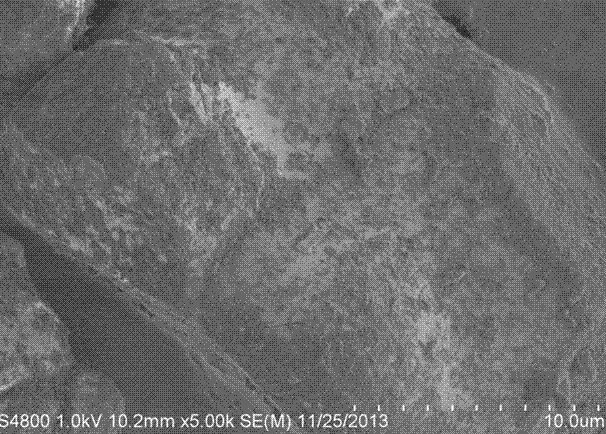Lithium ion batteries cathode material and preparation method thereof
A lithium-ion battery, cathode material technology, applied in battery electrodes, circuits, electrical components, etc., can solve the problem of the safety performance of cathode materials not being effectively improved, achieve anti-overcharge performance and thermal stability improvement, avoid decomposition, The effect of improving the discharge capacity
- Summary
- Abstract
- Description
- Claims
- Application Information
AI Technical Summary
Problems solved by technology
Method used
Image
Examples
Embodiment 1
[0039] A lithium battery positive electrode material provided in this embodiment includes composite oxide particles and a coating layer, and the composite oxide particles are lithium cobaltate LiCoO 2 , the particle size is 15um, and the cladding layer structure is LiMnSiO 4 , accounting for 2% by mass of the entire positive electrode material, and the thickness of the coating layer is 0.2um.
[0040] The preparation method is as follows:
[0041] Dissolve manganese sulfate in water to obtain a 0.1mol / L salt solution, add 1.00g of tetraethyl orthosilicate to 10mL of the above manganese sulfate solution, stir for 10h, then add 30g of lithium cobaltate LiCoO 2 Add it in, then fully stir for 2 hours to form a suspension, dry at 100°C for 15 hours, and burn at 500°C for 5 hours to obtain LiMnSiO 4 Coated LiCoO 2 cathode materials for lithium batteries.
Embodiment 2
[0043] A lithium battery positive electrode material provided in this embodiment includes composite oxide particles and a coating layer, and the composite oxide particles are doped lithium cobaltate LiCo 0.8 Ni 0.2 o 2 , the particle size is 8um, and the cladding structure is LiMn 0.9 Fe 0.1 SiO 4 , accounting for 0.1% by mass of the entire positive electrode material, and the thickness of the coating layer is 0.01um.
[0044] The preparation method is as follows:
[0045] Manganese chloride and ferric chloride were formulated into a 1.0mol / L mixed salt solution according to the molar ratio of 0.9:0.1, and 0.50 g of tetraethylorthosilicate was added to 20 ml of the above mixed salt solution, and after stirring for 12 hours, 35 g Li co 0.8 Ni 0.2 o 2Add it, and then fully stir for 2 hours to form a suspension, dry at 200°C for 10 hours, and sinter at 1000°C for 1 hour to obtain LiMn 0.9 Fe 0.1 SiO 4 Coated Li Co 0.8 Ni 0.2 o 2 cathode materials for lithium batter...
Embodiment 3
[0047] This embodiment provides a lithium battery positive electrode material, which includes composite oxide particles and a coating layer, and the composite oxide particles are doped lithium cobaltate LiCo 0.95 Mg 0.05 o 2 , the particle size is 20um, and the cladding structure is LiMn 0.9 Mg 0.1 SiO 4 , accounting for 10% by mass of the entire positive electrode material, and the thickness of the cladding layer is 1um.
[0048] The preparation method is as follows:
[0049] Manganese acetate and magnesium chloride were formulated into a 2 mol / L mixed salt solution at a molar ratio of 0.95:0.05, and 1.6 g of methyl orthosilicate was added to 20 mL of the above mixed salt solution, and after stirring for 12 hours, 30 g of LiCo 0.95 Mg 0.05 o 2 Add it into it, and then fully stir for 4 hours to form a suspension, dry at 50°C for 20 hours, and sinter at 300°C for 3 hours to obtain LiMn 0.9 Mg 0.1 SiO 4 Coated LiCo 0.95 Mg 0.05 o 2 cathode materials for lithium batt...
PUM
 Login to View More
Login to View More Abstract
Description
Claims
Application Information
 Login to View More
Login to View More - R&D
- Intellectual Property
- Life Sciences
- Materials
- Tech Scout
- Unparalleled Data Quality
- Higher Quality Content
- 60% Fewer Hallucinations
Browse by: Latest US Patents, China's latest patents, Technical Efficacy Thesaurus, Application Domain, Technology Topic, Popular Technical Reports.
© 2025 PatSnap. All rights reserved.Legal|Privacy policy|Modern Slavery Act Transparency Statement|Sitemap|About US| Contact US: help@patsnap.com



